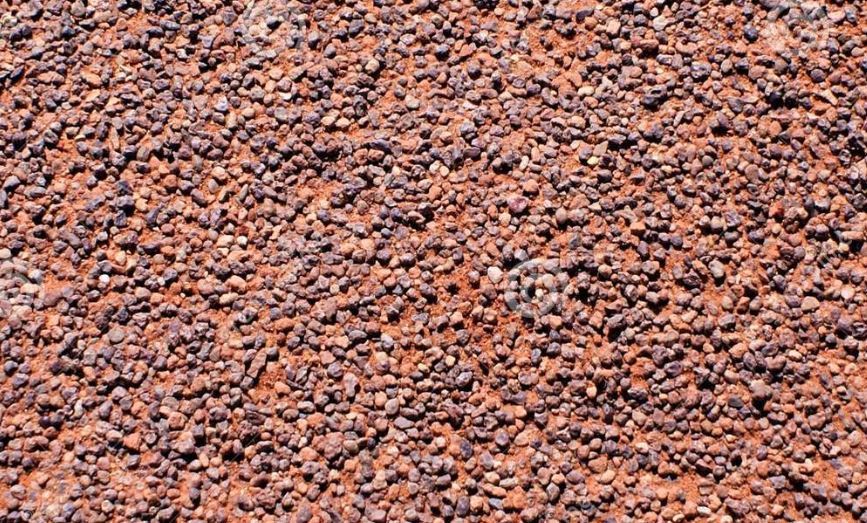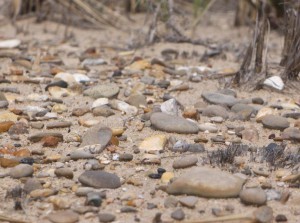
Lag deposit
Let us examine the words in this title and then move on to the geology lesson associated with this EarthCache.
Lag: (Verb) fail to keep up with another or others in movement or development. E.g. "they waited for Tim who was lagging behind"
Lag: (synonyms) - fall behind, hang back, fall back, trail (behind), linger, etc.
Deposit: is an accumulation of sediments, mineral ores, etc.
Therefore, as the title implies you are looking for something that has accumulated and left behind as a result of some action.

In the coordinates and in the surroundings, you will see accumulations of pebbles and small rocks that have been left behind from the wind erosion that has taken place here. These form coatings over the terrain.
The mechanism of how this works is simple:
- You have a mixture of fine sediment (sand) that is mixed with larger pebbles and small rocks. Therefore, there is a mixture of heavier pebbles and rocks with lighter sand.
- Because the sediment is unconsolidated, any wind blowing over the area will move the sand (lighter) rather than the (heavier) pebbles. Hence, you will eventually get to the point where there will be a layer of pebbles on top and sand below. In the deserts, this is also known as a desert pavement.
At the coordinates you can see ample evidence of this and to register a FOUND in this EC, all you have to do is take a nice stroll in the limestone cliffs between Praia da Empa and the Forte de Milreus and answer the following simple questions:
1- Estimate the area covered by the lag deposits. (> 100 m2; < 100 m2; >200 m2; < 200 m2;>500 m2)
2- Are the pebbles smooth or rough to the touch ?
3- Which is the predominant shape (round, oval, irregular) of the pebbles?
4- Measure the long axis (in the case of oval pebbles) of the pebbles. Give me a range in measurements from 10 pebbles you measured.
Thank you for visiting.

Depósito de lag
Vamos examinar as palavras neste título e depois passar para a aula de geologia associada a esta EarthCache.
Lag (Inglês): (Verbo) não consegue acompanhar outro ou outros em movimento ou desenvolvimento.
Lag: (sinónimos) - ficar para trás, atrasar-se, etc.
Depósito: é uma acumulação de sedimentos, minérios, etc.
Portanto, como o título indica, estás à procura de algo que foi acumulado e deixado para trás como resultado de alguma acção.

Nas coordenadas e nos seus arredores, verás acumulações de seixos e pequenas pedras que foram deixadas para trás pela erosão eólica que aqui ocorreu. Estas pedras formam revestimentos sobre o terreno.
O mecanismo de como isso funciona é simples:
1- Tens uma mistura de sedimentos finos (areia) com seixos maiores e pequenas pedras. Portanto, há uma mistura de pedras e pedras mais pesadas com areia mais clara.
2- Como o sedimento não é consolidado, qualquer vento que sopre sobre a área moverá a areia (mais leve) em vez dos seixos e das pedras (mais pesadas). Assim, vamos chegar ao ponto em que haverá uma camada de pedras no topo e areia por baixo. Nos desertos, este fenómeno também é conhecido como um pavimento deserto.
Nas coordenadas vais poder ver amplas evidências disso e para registrares esta EarthCache, vais ser preciso fazer um bom passeio nas falésias calcárias entre a Praia da Empa e o Forte de Milreus e responder às seguintes simples perguntas:
1- Estima a área coberta pelos depósitos lag. (> 100 m2; < 100 m2; >200 m2; < 200 m2;>500 m2)
2- As pedras são suaves ou ásperas ao toque?
3- Qual a forma predominante (redonda, oval, irregular) dos seixos?
4- Mede o eixo longo (no caso de pedrinhas ovais) dos seixos. Dê-me uma gama das medições de 10 pedras que mediste.
Obrigado pela visita.

 The most exciting way to learn about the Earth and its processes is to get into the outdoors and experience it first-hand. Visiting an Earthcache is a great outdoor activity the whole family can enjoy. An Earthcache is a special place that people can visit to learn about a unique geoscience feature or aspect of our Earth. Earthcaches include a set of educational notes and the details about where to find the location (latitude and longitude). Visitors to Earthcaches can see how our planet has been shaped by geological processes, how we manage the resources and how scientists gather evidence to learn about the Earth. To find out more click HERE.
The most exciting way to learn about the Earth and its processes is to get into the outdoors and experience it first-hand. Visiting an Earthcache is a great outdoor activity the whole family can enjoy. An Earthcache is a special place that people can visit to learn about a unique geoscience feature or aspect of our Earth. Earthcaches include a set of educational notes and the details about where to find the location (latitude and longitude). Visitors to Earthcaches can see how our planet has been shaped by geological processes, how we manage the resources and how scientists gather evidence to learn about the Earth. To find out more click HERE.